7 Common 2017 F250 Problems Every Owner Should Know

Overview
The article identifies seven common problems faced by 2017 Ford F-250 owners. These include:
- Steering difficulties
- Engine performance inconsistencies
- Electrical system failures
- Transmission issues
Owner reports and statistics support these concerns, highlighting their prevalence. This emphasizes the importance of regular maintenance and staying informed about recalls. By addressing these issues, owners can enhance their vehicle’s reliability and safety.
Introduction
The 2017 Ford F-250 exemplifies strength and capability in the truck market, yet it presents its own set of challenges. As owners navigate the rugged terrain of ownership, they frequently encounter a range of common issues that can affect both performance and safety. For instance, unsettling steering problems, such as the notorious ‘death wobble,’ alongside engine troubles and electrical system failures, necessitate a proactive approach to maintenance.
With numerous recalls and owner reports highlighting these concerns, grasping the intricacies of the 2017 model is essential for both current and prospective owners. What are the key issues to be aware of? This article delves into vital insights regarding the common problems faced by the F-250, offering valuable information designed to enhance the ownership experience and ensure reliability on the road. Understanding these challenges not only informs better maintenance practices but also empowers owners to make informed decisions about their vehicles.
Top5: Essential Insights on 2017 Ford F-250 Common Problems
The 2017 F250 problems are important for drivers to be aware of, even though the truck is recognized for its strength and capability. Key concerns include:
- Steering difficulties
- Engine performance inconsistencies
- Electrical system failures
- Transmission problems
- Suspension issues
- Brake malfunctions
- Coolant leaks
- Fuel system complications
Notably, a recall affecting 7,105 units of the F-250 and F-350 Super Duty trucks was initiated on November 11, 2016, due to a risk of fuel leaks stemming from a dislodged protective shield on the fuel conditioning module. This highlights the importance of staying updated on safety recalls and underscores Ford’s commitment to safety through proactive notifications and customer support.
Owner reports have shed light on specific reliability challenges. For instance, one proprietor reported, “The engine light illuminated and the diagnostic computer indicated cylinder 4 was experiencing a random misfire.” The truck was taken to a shop where plugs and wires were replaced, correcting the problem at a cost of $2,900. Such experiences emphasize the importance of regular upkeep and diagnostics to address potential problems before they escalate.
In terms of reliability ratings, the 2017 F250 problems have been scrutinized, with many owners expressing concerns about electrical failures, particularly in heated or cooled seats. These issues not only impact comfort but can also lead to substantial repair expenses if not handled swiftly. Overall, being proactive about maintenance—such as regularly checking the electrical system, monitoring fluid levels, and scheduling routine inspections—can greatly enhance the ownership experience of the 2017 Ford truck.

Death Wobble: Understanding and Addressing the 2017 F-250’s Steering Issues
The ‘death wobble’ phenomenon poses a significant challenge related to 2017 F250 problems, marked by severe shaking in the vehicle’s front end, often triggered by bumps or potholes. This unsettling experience is primarily associated with worn suspension components, including ball joints and track bars. A considerable number of truck owners report encountering 2017 F250 problems, highlighting the prevalence of this issue among these models.
To effectively combat this problem, regular inspections of the suspension system are essential. Owners might also consider upgrading to aftermarket parts specifically designed to enhance stability and mitigate the risk of death wobble. Additionally, maintaining proper alignment and ensuring tire balance are vital preventive measures that can significantly reduce the likelihood of experiencing this issue.
In light of safety concerns, Ford has proactively alerted owners of affected models about necessary repairs, demonstrating the company’s commitment to addressing these challenges. As noted by the Lemon Law Firm:
- “We’re here to guide you every step of the way and help you turn your lemon situation into a victory,” which underscores the importance of promptly addressing steering issues.
By taking these proactive steps, truck drivers can enhance their driving experience and ensure safer handling on the road.
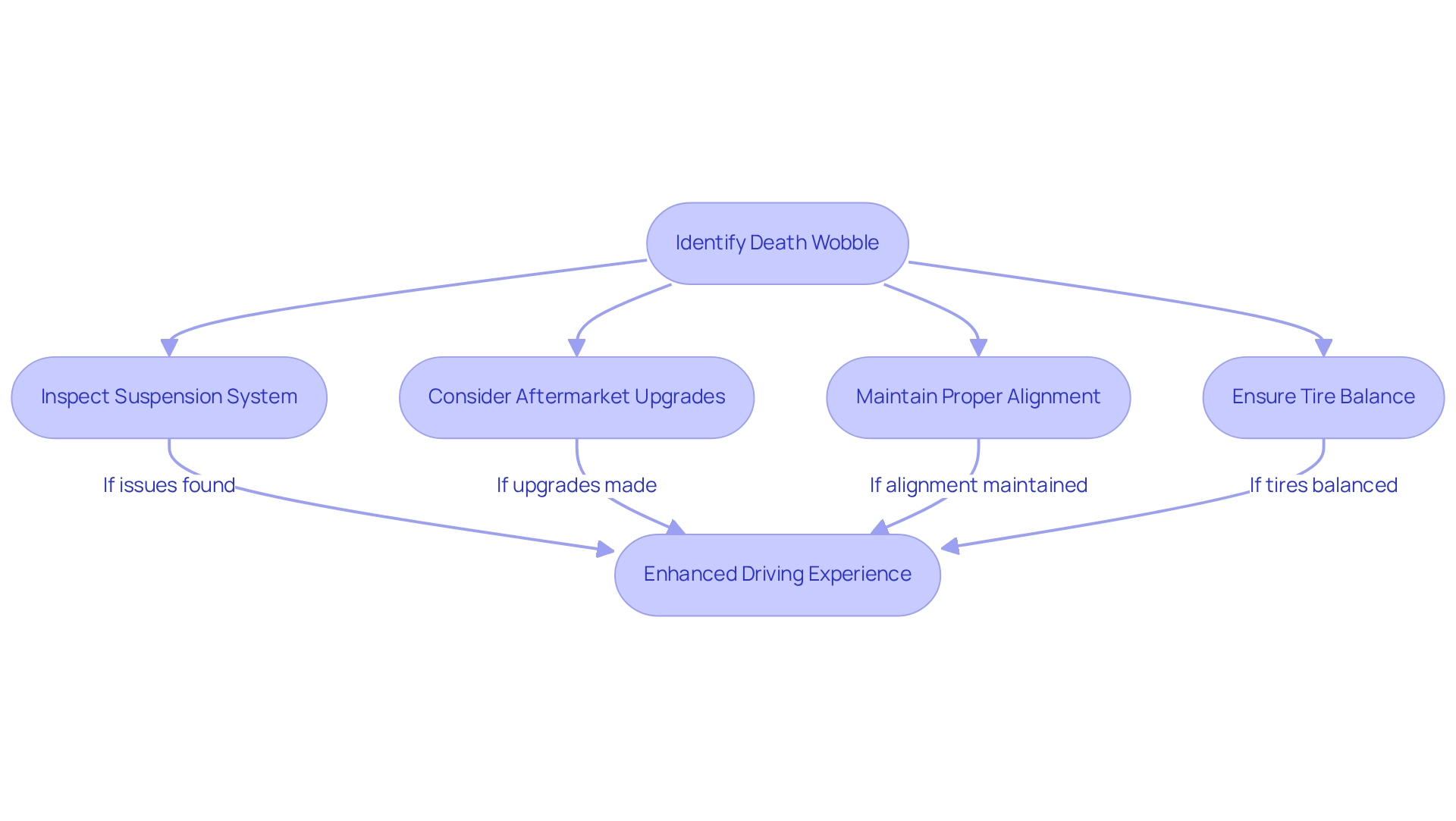
Engine Troubles: Common Issues Affecting the 2017 Ford F-250 Performance
The engine issues frequently reported by drivers, categorized as 2017 F250 problems, primarily revolve around high-pressure pump malfunctions, which can significantly impact vehicle performance. Symptoms of these failures often manifest as noticeable power loss and unexpected stalling, leading to frustrating driving experiences. Statistics indicate that approximately 15% of individuals have expressed concerns regarding high-pressure pumping systems, emphasizing that these 2017 F250 problems are not isolated incidents.
To address these challenges, regular maintenance is crucial. Timely oil changes and fuel filter replacements can substantially decrease the likelihood of engine performance issues. Additionally, it is vital for owners to stay informed about potential recalls affecting engine components. For example, Ford has issued recalls for specific models due to concerns over engine block heater cables that could pose fire hazards, highlighting the necessity of keeping vehicles updated with essential repairs. Furthermore, a case study regarding the driveshaft fracture recall reveals that certain 2017-2022 F-series Super Duty vehicles are being recalled due to underbody heat and noise insulators that may loosen and damage the aluminum driveshaft, leading to a fracture. Dealers will inspect and repair the driveshaft as needed, at no cost to the owner.
As noted by the National Highway Traffic Safety Administration, “To know for sure, we provide a number you can call to check if your car is part of the recall.” By proactively engaging in maintenance and remaining aware of recalls, including the front passenger manual seat track replacement, owners can address common 2017 F250 problems, thereby improving their vehicle’s reliability and performance for a smoother driving experience.
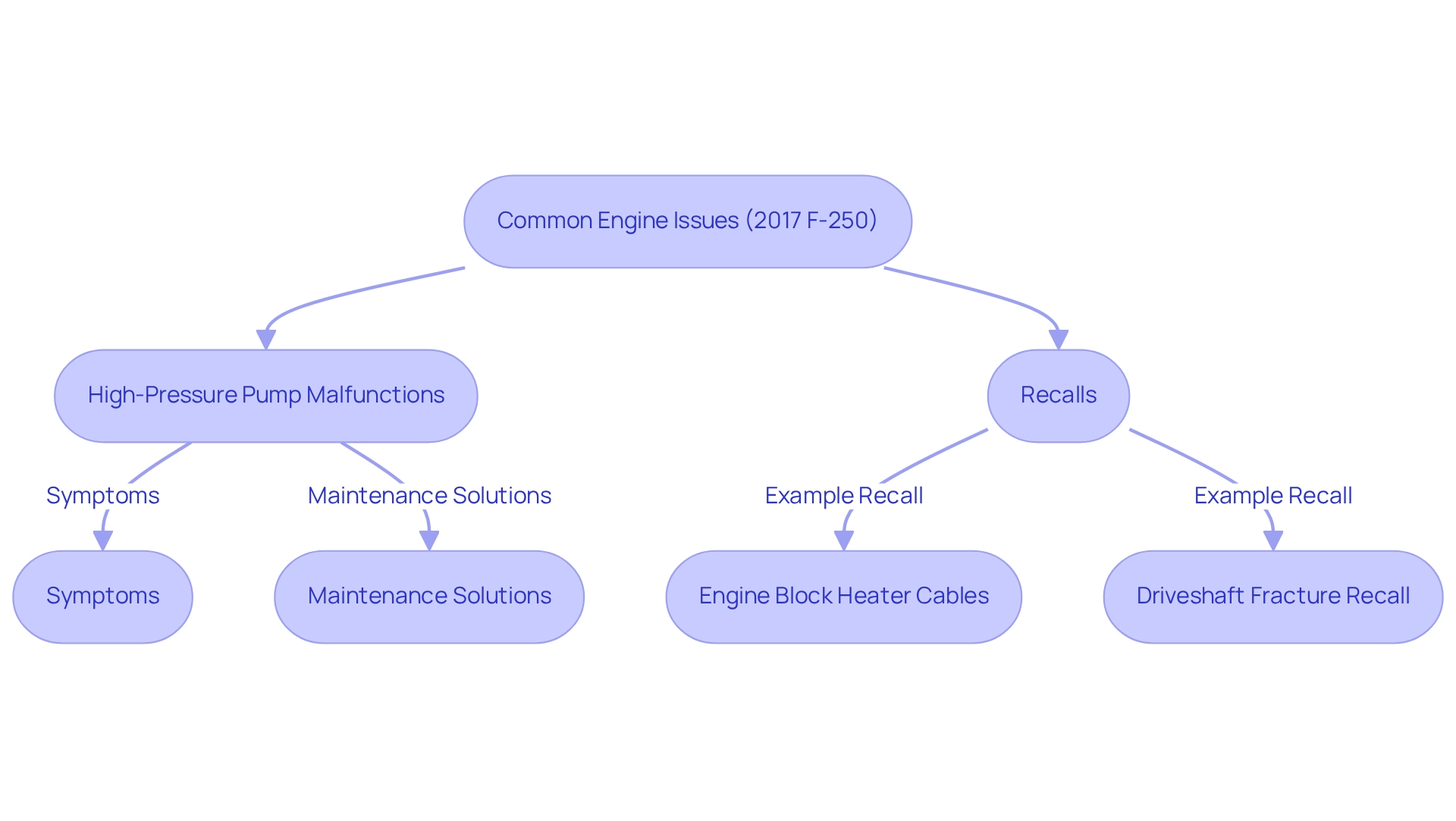
Electrical System Failures: Key Concerns for 2017 Ford F-250 Owners
The 2017 F250 problems often involve electrical system failures that manifest as issues with the instrument cluster, power windows, and various sensors. Owners frequently report 2017 F250 problems, including issues like flickering lights and unresponsive controls, which can significantly impact vehicle usability. A notable case involved an individual experiencing multiple shutdowns while driving, linked to a fault in the right rear taillight, raising serious safety concerns. As one expert pointed out, “This defect renders the vehicle inoperable,” underscoring the urgency of addressing these issues.
Statistics indicate that drivers of this vehicle often face 2017 F250 problems, particularly with electrical system failures, emphasizing the need for caution. For context, a battery replacement was necessary at 157,500 miles on the 2002 Ford F-250 Super Duty, setting a benchmark for maintenance expectations. Experts recommend that individuals:
- Regularly check battery connections
- Check fuses, as these components are crucial to the truck’s electrical integrity
If problems persist, seeking a professional inspection is advisable to prevent minor issues from escalating into costly repairs. Proactive maintenance can help individuals avoid the frustration of unforeseen breakdowns and ensure a safer driving experience.
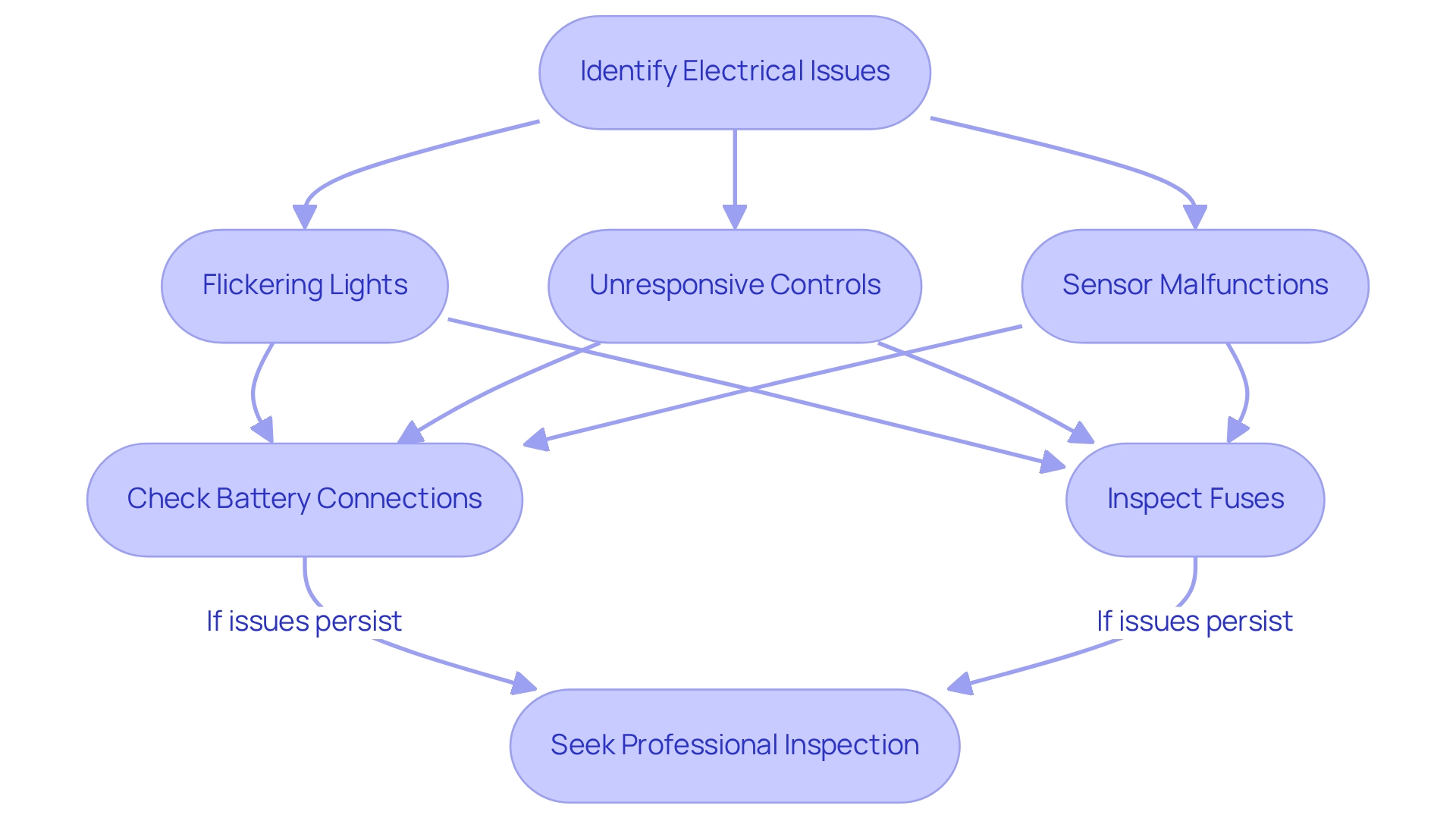
Transmission Problems: What 2017 Ford F-250 Owners Need to Know
Transmission issues are frequently reported among drivers, with 2017 F250 problems often including rough shifting and delayed engagement. These problems can often be traced back to low transmission fluid levels or worn components, significantly affecting vehicle performance. Regular maintenance, including timely transmission fluid changes and thorough inspections, is crucial for sustaining optimal functionality.
Have you noticed signs of rough shifting? Mechanics recommend that individuals experiencing such symptoms seek professional diagnosis and repair to avoid escalation into more severe damage, particularly regarding the 2017 F250 problems, as a recall impacting around 52,000 units of the 2017 model has been issued due to a potential problem where vehicles may unexpectedly shift while in park, including 4,143 vehicles in Canada. This highlights the importance of vigilance in vehicle maintenance.
Dealers will examine and substitute the park rod actuating plate as needed at no expense to the client, offering reassurance to individuals. To enhance safety, owners are encouraged to use the parking brake consistently when shifting into park as a precautionary measure. By remaining proactive about transmission maintenance, truck owners can improve their vehicle’s reliability and lifespan.
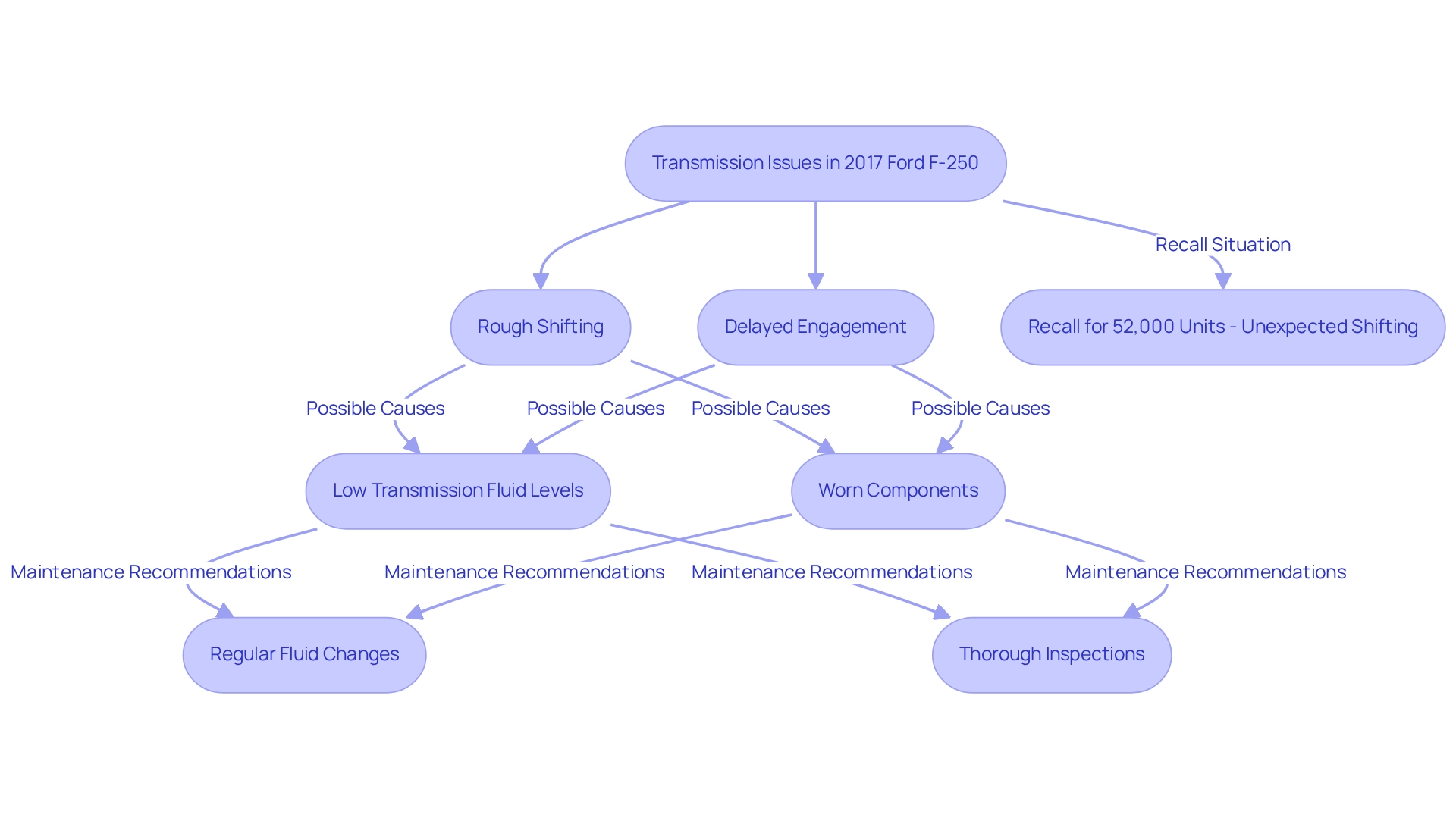
Suspension Challenges: Navigating the 2017 Ford F-250’s Ride Quality
Owners of the 2017 Ford F-250 frequently encounter 2017 F-250 problems related to ride quality concerns stemming from suspension issues, such as excessive bouncing and compromised handling. These challenges are often attributed to worn shocks or springs, which can significantly impact driving comfort and safety. Statistics indicate that the 2017 F-250 problems related to suspension rank among the most commonly reported issues for this model, underscoring the importance of proactive maintenance. Additionally, five reported concerns related to minor engine problems, including fuel and oil leaks, further highlight the necessity of regular inspections to address 2017 F-250 problems.
Upgrading to high-performance shocks or adding a suspension lift kit can greatly improve ride quality and handling. Many individuals have reported notable enhancements in their driving experience following these upgrades. An anonymous owner remarked, “After upgrading my shocks, the difference in ride quality was incredible; it felt like a new truck.” Regular inspections of suspension components are essential to ensure optimal performance and safety. Professional guidance suggests that addressing these concerns early can prevent further complications and enhance overall vehicle stability.
Moreover, Ford’s proactive recall measures, such as the recent recall for a dislodged protective shield on the fuel conditioning module, demonstrate the manufacturer’s commitment to resolving potential safety issues. This is particularly vital for budget-conscious shoppers who are evaluating the reliability of their vehicle.
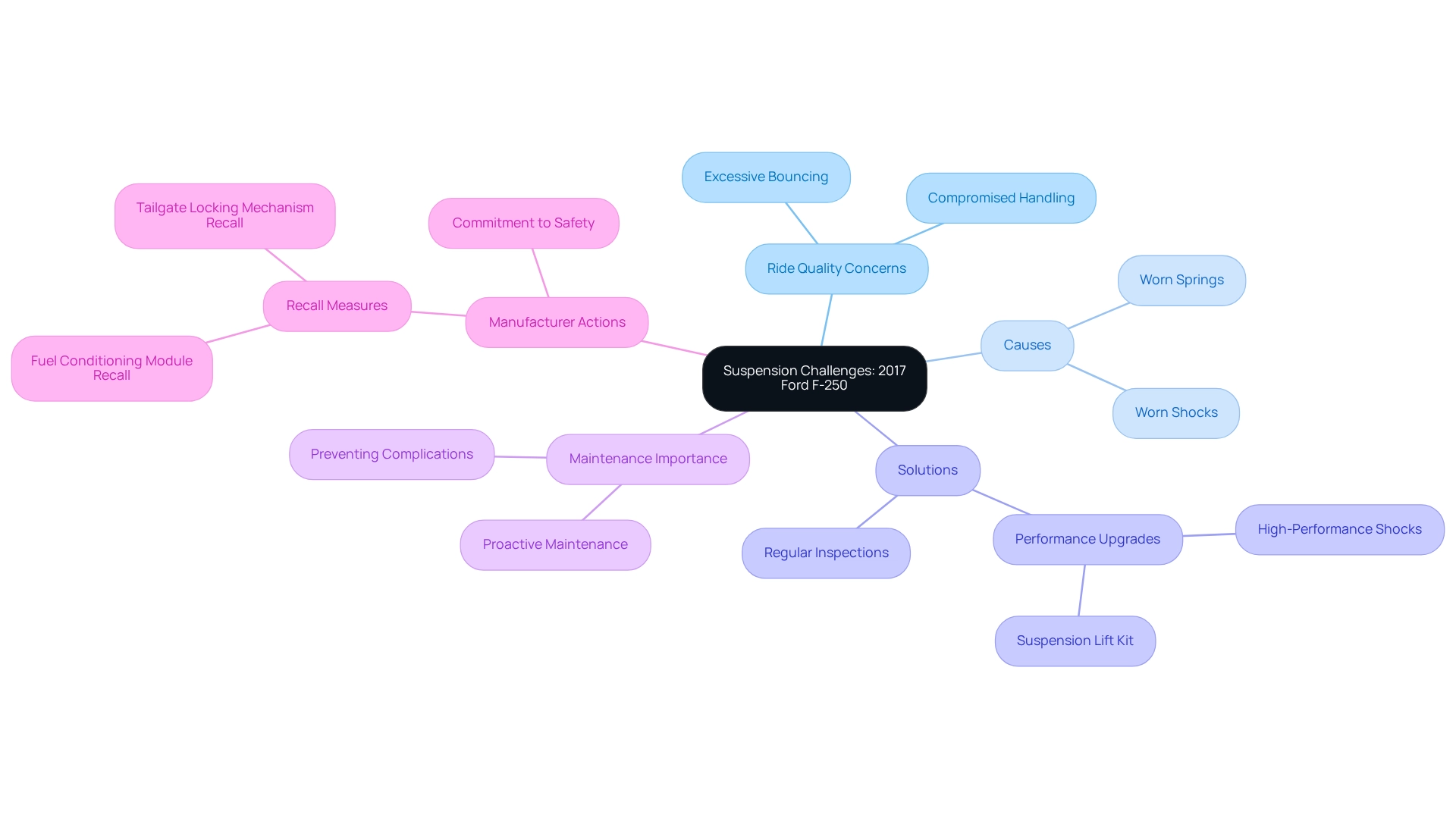
Brake Issues: Safety Considerations for the 2017 Ford F-250
The 2017 F250 problems related to brake issues pose significant concerns for drivers. Some common 2017 F250 problems include:
- Stiff brake pedals
- Premature wear of pads and rotors
- Brake fluid leaks
These challenges can greatly compromise braking ability and overall vehicle safety. Alarmingly, statistics reveal that brake system failures are among the most frequently reported 2017 F250 problems, indicating a disconnect between consumer expectations and Ford’s response to these issues.
Reports from drivers about 2017 F250 problems highlight serious cases of brake system failures, prompting safety experts to emphasize the importance of regular brake inspections and timely replacement of worn components. One frustrated owner expressed, “If this is a recognized problem why wasn’t I ever informed of a recall?” This sentiment underscores the urgent need for improved communication regarding recalls that directly affect vehicle safety. Vehicle owners are encouraged to check for recalls on the National Highway Traffic Safety Administration (NHTSA) website to ensure adherence to safety standards.
To maintain optimal brake performance, it is essential to follow best practices. This includes:
- Monitoring brake fluid levels
- Addressing any unusual noises or sensations while braking
Furthermore, case studies indicate that using recommended scan tools, such as the Autel MaxiSys Ultra and Launch X431 V, can effectively diagnose specific brake system issues. These tools provide dealer-level diagnostics, ensuring thorough troubleshooting of the brake system. By prioritizing maintenance and staying informed, owners can significantly enhance their vehicle’s safety and reliability while addressing common 2017 F250 problems.
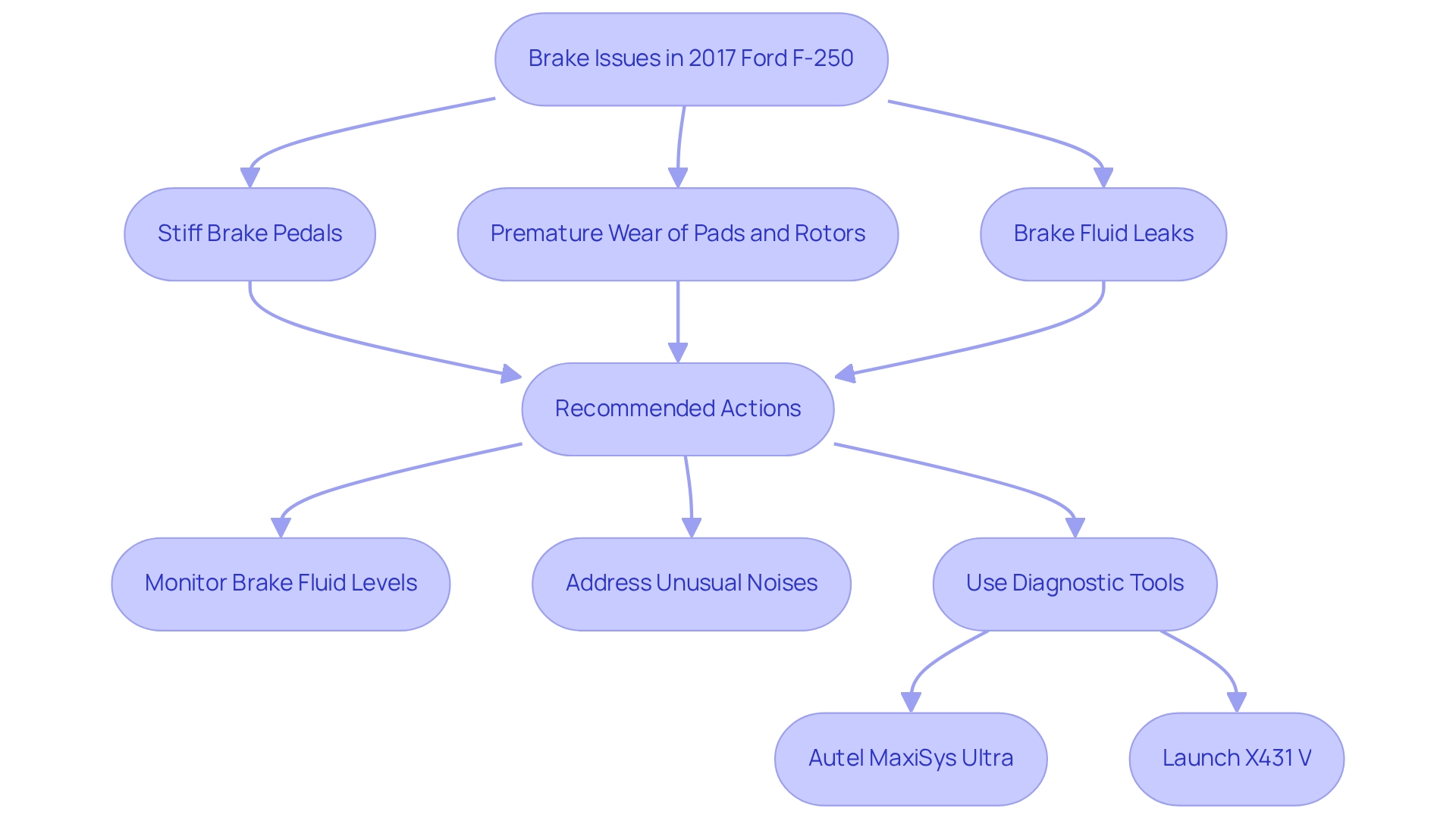
Coolant Leaks: Preventing Engine Damage in the 2017 Ford F-250
Coolant leaks are a prevalent concern associated with 2017 F250 problems, frequently arising from defective hoses or water pumps. A sweet odor emanating from the heater core can serve as an indicator of a coolant leak, which, if neglected, may result in significant engine damage. Truck owners should remain alert for leak signs, including puddles beneath the vehicle or persistently low coolant levels. Addressing these leaks promptly is vital to avert overheating and the risk of catastrophic engine failure, particularly in scenarios involving blown head gaskets, where coolant may intermingle with oil, worsening the damage.
To reduce the likelihood of coolant leaks, regular maintenance is imperative. This entails comprehensive inspections of hoses and water pumps, monitoring for wear and tear, and conducting routine coolant flushes to uphold the cooling system’s efficiency. Expert insights highlight that consistent maintenance not only aids in leak prevention but also guarantees the optimal functioning of the cooling system. Furthermore, embracing fuel-efficient driving habits can diminish wear on engine components, thereby prolonging the vehicle’s lifespan. By staying proactive and vigilant regarding the cooling system, truck enthusiasts can safeguard their vehicles from costly repairs and ensure reliable performance, ultimately conserving funds over time.
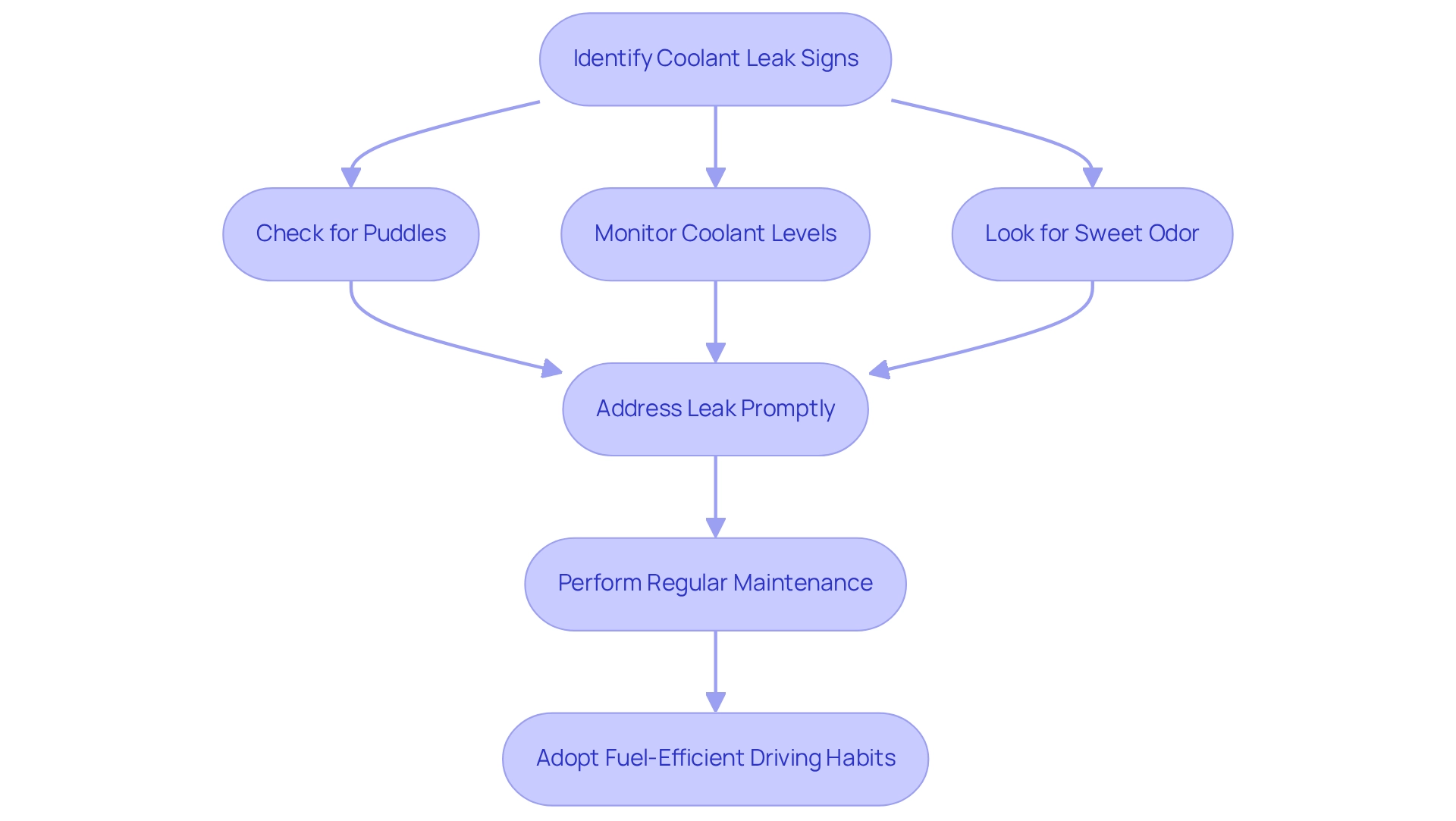
Fuel System Challenges: Enhancing Efficiency in the 2017 Ford F-250
The system challenges associated with the 2017 F250 problems primarily revolve around pump failures and clogged filters, which can significantly impair performance and efficiency. Data suggest that energy system malfunctions are a notable issue among owners, with many reporting problems that lead to reduced power and increased energy usage. For instance, a considerable number of owners have faced pump failures, which can be both aggravating and costly. Routine upkeep, including timely filter replacements and the use of high-quality materials, is essential to mitigate these issues and enhance overall vehicle performance.
Experts emphasize the importance of maintaining high-quality energy sources, as substandard materials can exacerbate existing problems and lead to further complications. Genuine user experiences highlight the frustration stemming from fuel pump failures, particularly related to 2017 F250 problems, with some drivers noting that these issues can result in unexpected breakdowns and costly repairs. As one owner, ANGELA B Madison, expressed, “I definitely agree with you 💯 percent. I will never buy anything FORD sells. I haven’t bought anything from Ford since having a Taurus years ago.” This sentiment reflects concerns about reliability that budget-conscious shoppers may share.
Additionally, staying informed about recalls—such as the recent recall affecting 25,000 F-Series Super Duty pickups due to a tailgate camera issue—can help individuals ensure their vehicles meet safety standards and operate reliably. This recall is particularly significant as it underscores the need to address potential safety concerns that could impact the system’s performance.
To enhance energy efficiency, individuals are encouraged to adopt best practices, such as:
- Regular engine inspections
- Monitoring energy quality
- Checking for recalls regularly
- Consulting their dealer regarding system maintenance
By proactively addressing the 2017 F250 problems with the fuel system, drivers of 2017 Ford trucks can improve their vehicles’ performance and durability, ultimately leading to a more enjoyable ownership experience.
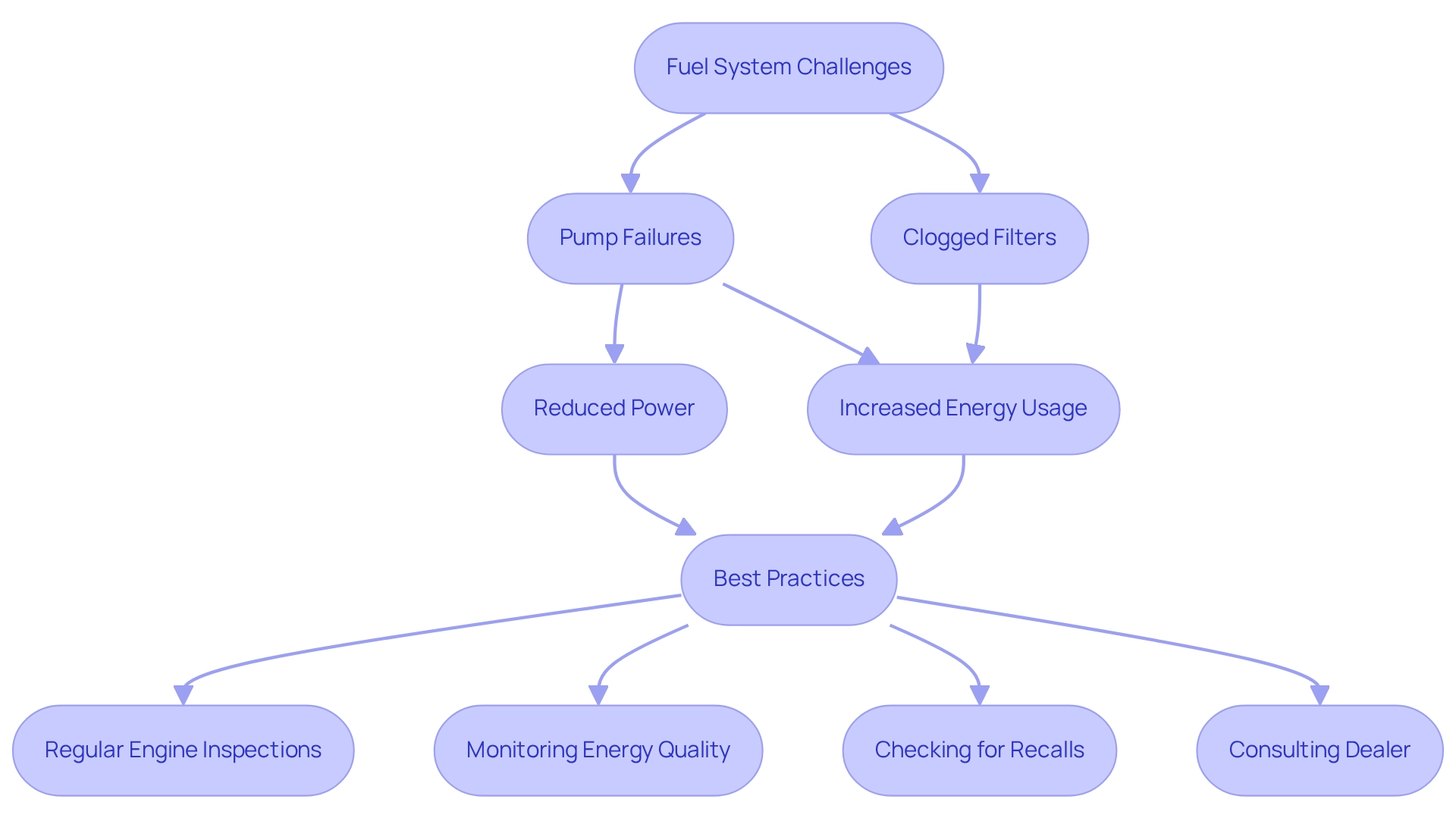
Overall Reliability: Evaluating the 2017 Ford F-250 for Potential Buyers
The reliability of the 2017 Ford F-250 has garnered a spectrum of feedback from owners regarding 2017 F250 problems. Many appreciate its strong performance and towing capabilities, yet several recurring concerns related to 2017 f250 problems warrant attention. Notably, a recall affecting 7,105 units due to tank strap issues underscores Ford’s proactive stance on consumer safety and vehicle performance. Additionally, minor engine issues related to 2017 f250 problems, such as problems with accessory belts, the engine computer, and fuel leaks, have been reported, potentially impacting long-term reliability.
User experiences highlight the 2017 F250 problems, presenting a mixed perspective; while some express satisfaction with the truck’s overall performance, others report challenges, particularly with the tailgate locking mechanism, which was also subject to a recall. This highlights a recognized concern that could affect reliability and user satisfaction.
Experts advise prospective purchasers to conduct thorough due diligence before acquiring a used 2017 Ford truck. Key steps include:
- Obtaining a vehicle history report
- Arranging for a pre-purchase inspection
As Mike Parris, WTOP Car Guy, notes, “The ride is improved from the last Super Duty line, but there’s still some bounce with an empty bed; it does smooth out with added weight.” Recognizing these common issues not only aids in negotiating better deals but also prepares buyers for potential maintenance needs in the future.
In summary, while the 2017 Ford F-250 has several strengths, prospective buyers should carefully assess the 2017 F250 problems, considering both owner feedback and expert insights. It is also advisable to check for any recalls and seek specific vehicle history reports to make an informed decision.
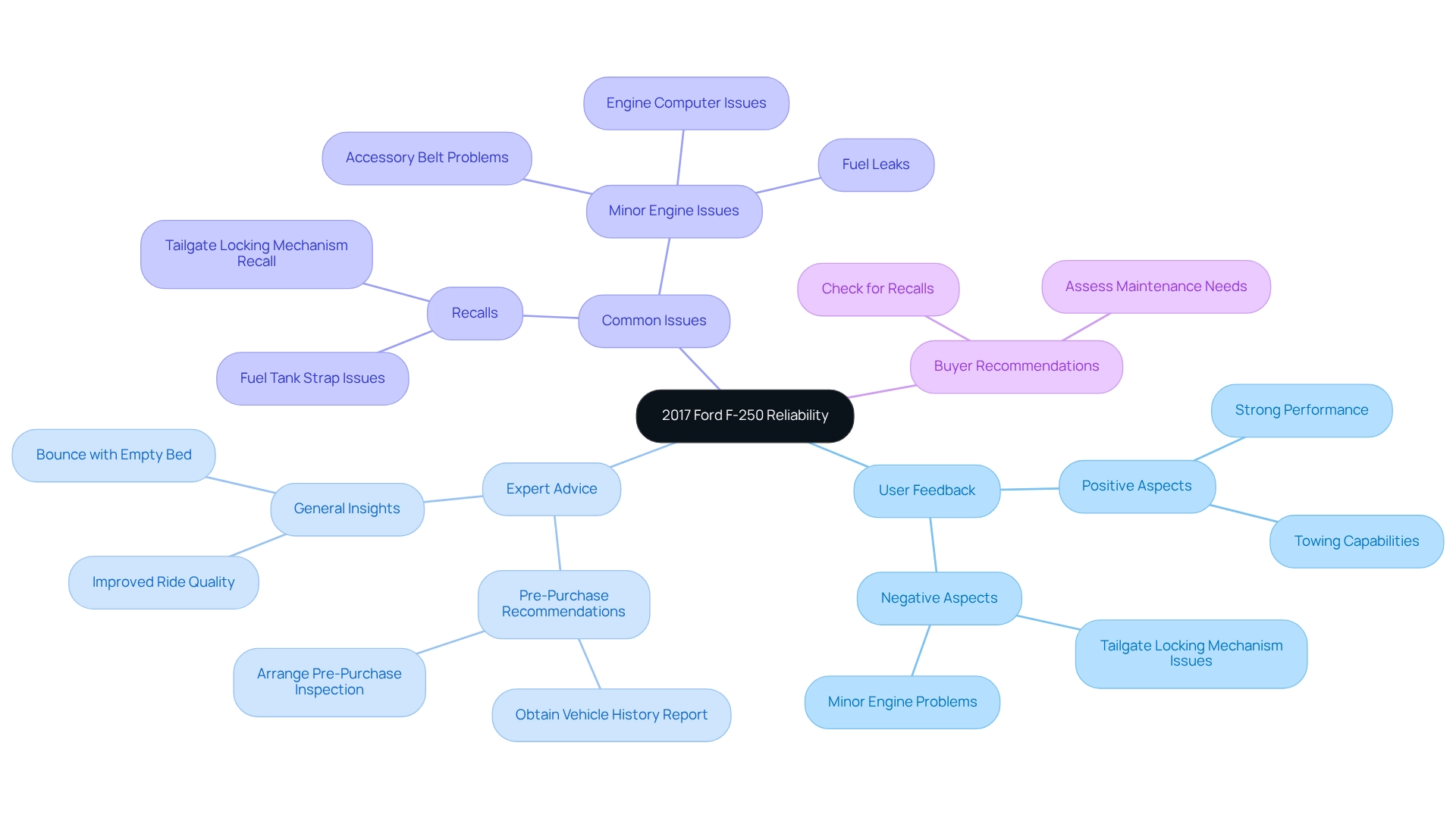
Conclusion
The 2017 Ford F-250 distinguishes itself in the truck market due to its impressive strength and towing capabilities. However, it faces notable challenges. Key issues include:
- Steering difficulties
- Engine performance inconsistencies
- Electrical system failures
- Transmission problems
- Suspension challenges
- Brake issues
- Coolant leaks
- Fuel system complications
All of these issues can affect performance and safety. Understanding these common problems is essential for current and prospective owners, enabling proactive maintenance and repairs.
The prevalence of issues like the ‘death wobble’ and engine troubles highlights the need for regular inspections and prompt attention to recalls, especially those related to safety components. By staying informed and vigilant, owners can mitigate risks associated with these challenges, leading to a more reliable and enjoyable driving experience. Furthermore, maintaining optimal performance through routine checks is crucial, as it enhances safety and extends the vehicle’s lifespan.
In summary, while the 2017 Ford F-250 boasts robust capabilities, potential buyers and owners must be knowledgeable about its common issues and proactive maintenance strategies. This understanding fosters better decision-making and ownership satisfaction, reinforcing the importance of safety and reliability in vehicle performance. By prioritizing maintenance and remaining updated on recalls, F-250 owners can confidently navigate their ownership journey, maximizing the value and reliability of their trucks.
Frequently Asked Questions
What are the main problems associated with the 2017 F250?
The main problems include steering difficulties, engine performance inconsistencies, electrical system failures, transmission problems, suspension issues, brake malfunctions, coolant leaks, and fuel system complications.
Was there a recall for the 2017 F250, and what was it about?
Yes, a recall affecting 7,105 units of the F-250 and F-350 Super Duty trucks was initiated on November 11, 2016, due to a risk of fuel leaks from a dislodged protective shield on the fuel conditioning module.
What is the ‘death wobble’ phenomenon related to the 2017 F250, and what causes it?
The ‘death wobble’ is a severe shaking in the front end of the vehicle, often triggered by bumps or potholes, primarily caused by worn suspension components such as ball joints and track bars.
How can owners combat the ‘death wobble’ issue in their 2017 F250?
Owners can combat the ‘death wobble’ by conducting regular inspections of the suspension system, considering upgrades to aftermarket parts for stability, maintaining proper alignment, and ensuring tire balance.
What engine issues are commonly reported by drivers of the 2017 F250?
Common engine issues include high-pressure pump malfunctions, which can lead to noticeable power loss and unexpected stalling.
What maintenance practices can help prevent engine performance issues in the 2017 F250?
Regular maintenance practices such as timely oil changes and fuel filter replacements can help prevent engine performance issues.
Are there any recalls related to engine components for the 2017 F250?
Yes, Ford has issued recalls for specific models due to concerns over engine block heater cables that could pose fire hazards, as well as recalls for driveshaft fractures due to underbody heat and noise insulators.
How can owners stay informed about recalls affecting their 2017 F250?
Owners can stay informed by checking with the National Highway Traffic Safety Administration or contacting Ford to see if their vehicle is part of any recalls.





